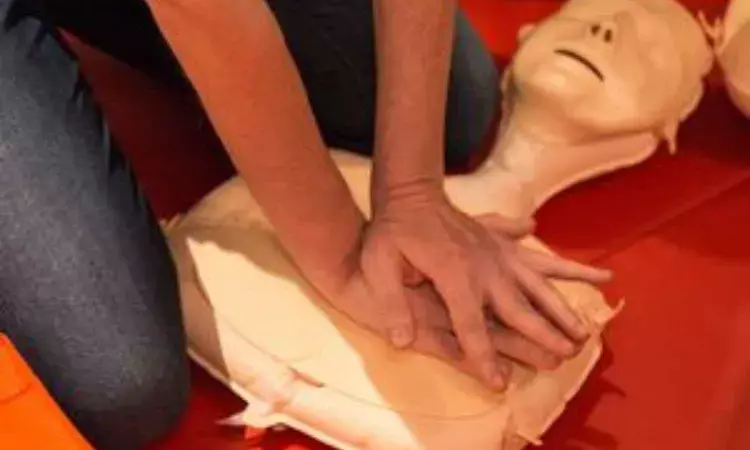- Home
- Medical news & Guidelines
- Anesthesiology
- Cardiology and CTVS
- Critical Care
- Dentistry
- Dermatology
- Diabetes and Endocrinology
- ENT
- Gastroenterology
- Medicine
- Nephrology
- Neurology
- Obstretics-Gynaecology
- Oncology
- Ophthalmology
- Orthopaedics
- Pediatrics-Neonatology
- Psychiatry
- Pulmonology
- Radiology
- Surgery
- Urology
- Laboratory Medicine
- Diet
- Nursing
- Paramedical
- Physiotherapy
- Health news
- Fact Check
- Bone Health Fact Check
- Brain Health Fact Check
- Cancer Related Fact Check
- Child Care Fact Check
- Dental and oral health fact check
- Diabetes and metabolic health fact check
- Diet and Nutrition Fact Check
- Eye and ENT Care Fact Check
- Fitness fact check
- Gut health fact check
- Heart health fact check
- Kidney health fact check
- Medical education fact check
- Men's health fact check
- Respiratory fact check
- Skin and hair care fact check
- Vaccine and Immunization fact check
- Women's health fact check
- AYUSH
- State News
- Andaman and Nicobar Islands
- Andhra Pradesh
- Arunachal Pradesh
- Assam
- Bihar
- Chandigarh
- Chattisgarh
- Dadra and Nagar Haveli
- Daman and Diu
- Delhi
- Goa
- Gujarat
- Haryana
- Himachal Pradesh
- Jammu & Kashmir
- Jharkhand
- Karnataka
- Kerala
- Ladakh
- Lakshadweep
- Madhya Pradesh
- Maharashtra
- Manipur
- Meghalaya
- Mizoram
- Nagaland
- Odisha
- Puducherry
- Punjab
- Rajasthan
- Sikkim
- Tamil Nadu
- Telangana
- Tripura
- Uttar Pradesh
- Uttrakhand
- West Bengal
- Medical Education
- Industry
Optimizing Diastolic BP and End-Tidal Carbon Dioxide key Predictors of Return of Spontaneous Circulation During CPR: Study

Recent study aimed to evaluate the association between diastolic blood pressure (DBP), end-tidal carbon dioxide (ETCO2), and the return of spontaneous circulation (ROSC) during cardiopulmonary resuscitation (CPR) in adult out-of-hospital cardiac arrest (OHCA) patients.
The study was a preplanned sub-analysis of the Augmented Medication CardioPulmonary Resuscitation (AMCPR) trial, which enrolled 180 OHCA patients with invasive DBP monitoring. An additional 84 patients with initial DBP above 20 mmHg were included in this analysis.
Data Extraction
The researchers extracted initial (within 5 min), follow-up (around 10 min), and delta (follow-up minus initial) values of DBP and ETCO2, and the primary outcome was sustained ROSC (≥20 min).
Results Overview
The results showed that among the 264 patients, 101 (38.3%) achieved sustained ROSC, and 24 (23.8%) were discharged with survival, with 5 (20.8%) showing good neurological function recovery. Patients without ROSC had significantly lower DBP values at all time points compared to those with ROSC. For ETCO2, only the follow-up value was lower in the no ROSC group.
ROC Curve Analysis
Receiver operating characteristic (ROC) curve analysis revealed that follow-up DBP had the highest area under the curve (AUROC) of 0.83 for predicting sustained ROSC, followed by delta DBP with an AUROC of 0.75. A follow-up DBP above 27 mmHg showed the highest sensitivity (73.5%), positive predictive value (76.3%), and negative predictive value (81.7%), while a delta DBP above 7 mmHg exhibited the highest specificity (85.2%).
Multivariate Analysis
In the multivariate analysis, follow-up DBP above 26.5 mmHg (adjusted OR 10.03) and delta DBP above 6.5 mmHg (adjusted OR 4.83) were independently associated with a higher likelihood of achieving sustained ROSC.
Conclusions
The authors conclude that DBP, particularly follow-up and delta values, is a superior prognostic marker compared to ETCO2 for predicting the likelihood of sustained ROSC in adult OHCA patients. Incorporating DBP monitoring during CPR may aid in treatment planning and prognostication.
Key Points
1.The study aimed to evaluate the association between diastolic blood pressure (DBP), end-tidal carbon dioxide (ETCO2), and the return of spontaneous circulation (ROSC) during cardiopulmonary resuscitation (CPR) in adult out-of-hospital cardiac arrest (OHCA) patients.
2. The study was a preplanned sub-analysis of the Augmented Medication CardioPulmonary Resuscitation (AMCPR) trial, which enrolled 180 OHCA patients with invasive DBP monitoring, and an additional 84 patients with initial DBP above 20 mmHg were included in the analysis.
3. The results showed that among the 264 patients, 101 (38.3%) achieved sustained ROSC, and 24 (23.8%) were discharged with survival, with 5 (20.8%) showing good neurological function recovery. Patients without ROSC had significantly lower DBP values at all time points compared to those with ROSC, while for ETCO2, only the follow-up value was lower in the no ROSC group.
4. Receiver operating characteristic (ROC) curve analysis revealed that follow-up DBP had the highest area under the curve (AUROC) of 0.83 for predicting sustained ROSC, followed by delta DBP with an AUROC of 0.75. A follow-up DBP above 27 mmHg showed the highest sensitivity (73.5%), positive predictive value (76.3%), and negative predictive value (81.7%), while a delta DBP above 7 mmHg exhibited the highest specificity (85.2%).
5. In the multivariate analysis, follow-up DBP above 26.5 mmHg (adjusted OR 10.03) and delta DBP above 6.5 mmHg (adjusted OR 4.83) were independently associated with a higher likelihood of achieving sustained ROSC.
6. The authors conclude that DBP, particularly follow-up and delta values, is a superior prognostic marker compared to ETCO2 for predicting the likelihood of sustained ROSC in adult OHCA patients, and incorporating DBP monitoring during CPR may aid in treatment planning and prognostication.
Reference –
June-Sung Kim et al. (2025). Diastolic Blood Pressures And End Tidal Carbon Dioxides During Cardiopulmonary Resuscitations And Their Association With Outcomes In Adult Out-Of-Hospital Cardiac Arrest Patients: A Preplanned Secondary Analysis Of The Augmented Medication CardioPulmonary Resuscitation (AMCPR) Trial.. *Resuscitation*,110537 . https://doi.org/10.1016/j.resuscitation.2025.110537.
MBBS, MD (Anaesthesiology), FNB (Cardiac Anaesthesiology)
Dr Monish Raut is a practicing Cardiac Anesthesiologist. He completed his MBBS at Government Medical College, Nagpur, and pursued his MD in Anesthesiology at BJ Medical College, Pune. Further specializing in Cardiac Anesthesiology, Dr Raut earned his FNB in Cardiac Anesthesiology from Sir Ganga Ram Hospital, Delhi.


